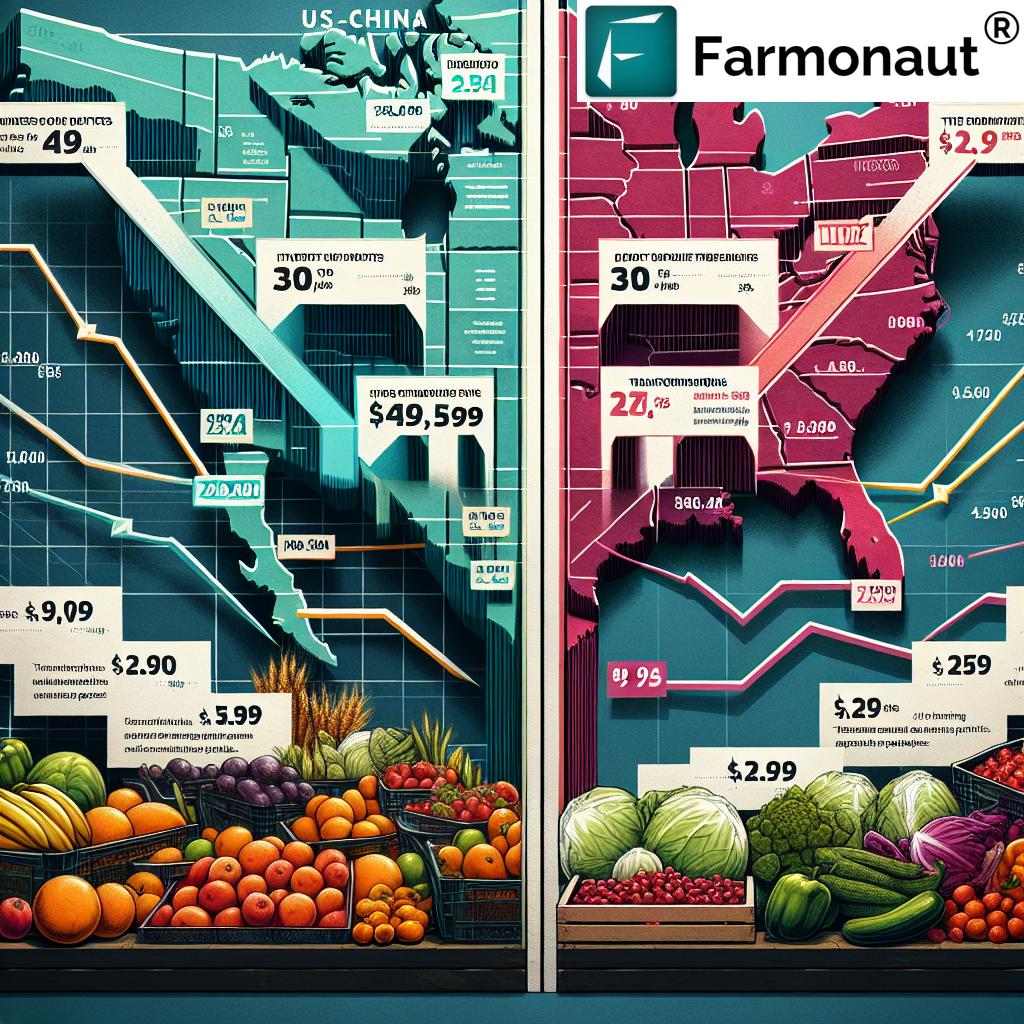Mastering Silage Fermentation: A Midwest Farmer’s Guide to High-Quality Livestock Feed Storage
“Proper silage fermentation can reduce dry matter losses by up to 20%, significantly improving feed efficiency for livestock.”
Welcome to our comprehensive guide on silage fermentation techniques, tailored specifically for Midwest farmers looking to optimize their livestock feed management. In this article, we’ll explore the essential factors for producing high-quality silage storage and maintaining ideal moisture content. Whether you’re managing a small farm or a large agricultural operation in states like Illinois or Iowa, this guide will provide valuable insights to transform your forage preservation practices and boost your farm’s efficiency.
Understanding Silage Fermentation: The Foundation of Quality Feed
Silage fermentation is a critical process in preserving forage crops for livestock feed. It involves the anaerobic fermentation of harvested plant material, which converts sugars into organic acids, primarily lactic acid. This process not only preserves the nutrients in the forage but also enhances its palatability and digestibility for livestock.
For Midwest farmers, mastering silage fermentation techniques is crucial for several reasons:
- Extends feed storage life
- Maintains nutritional value of harvested crops
- Reduces feed costs
- Improves overall farm efficiency
Let’s dive into the key factors that influence silage fermentation and how to optimize them for the best results.
Optimizing Silage Packing Density: A Critical Step
One of the most crucial aspects of successful silage fermentation is achieving optimal packing density. Proper packing density helps exclude oxygen from the silage, which is essential for promoting anaerobic fermentation and preventing spoilage.
“Optimal silage packing density of 14-16 lbs/ft³ can extend storage life by 30-50% compared to poorly packed silage.”
Here are some tips to optimize silage packing density:
- Use heavy tractors or specialized packing equipment
- Pack in thin layers (6-8 inches)
- Adjust tire pressure for better surface contact
- Ensure even distribution across the entire surface
Remember, proper packing is especially important in the Midwest, where varying weather conditions can impact silage quality. By achieving the right density, you’ll create an environment that promotes rapid fermentation and minimizes spoilage.
Maintaining Ideal Moisture Content for Silage
Moisture content plays a pivotal role in silage fermentation. Too much moisture can lead to excessive seepage and nutrient loss, while too little can hinder proper fermentation. For most crops in the Midwest, the ideal moisture content for silage ranges between 60-70%.
To maintain ideal moisture content:
- Monitor weather conditions before harvesting
- Use moisture testing equipment regularly
- Adjust harvest timing based on plant maturity and moisture levels
- Consider using inoculants to aid fermentation in drier conditions
By carefully managing moisture content, you’ll create an environment that promotes efficient fermentation and preserves valuable nutrients for your livestock.
[Include image 1 here with specified formatting]
Timing Your Forage Harvesting for Optimal Silage Quality
The timing of forage harvesting is critical for producing high-quality silage. In the Midwest, where growing conditions can vary significantly, it’s essential to monitor your crops closely and harvest at the right stage of maturity.
Key considerations for harvest timing include:
- Plant maturity: Affects sugar content and digestibility
- Dry matter content: Aim for 30-35% for most crops
- Weather conditions: Avoid harvesting during wet periods
- Equipment availability: Ensure all necessary machinery is ready
For corn silage, a popular choice in the Midwest, harvesting at the right stage of maturity is crucial. Aim to harvest when the kernels are at the “dent” stage and the milk line has moved about 1/2 to 2/3 down the kernel.
Controlling Oxygen Exposure: The Key to Anaerobic Fermentation
Minimizing oxygen exposure is essential for promoting anaerobic fermentation in agriculture. Oxygen allows undesirable microorganisms to thrive, leading to spoilage and reduced feed quality. Here’s how to control oxygen exposure effectively:
- Fill silos or bunkers quickly to reduce air pockets
- Use proper sealing techniques (e.g., plastic covers, weights)
- Maintain airtight storage conditions
- Minimize feed-out face exposure during use
By effectively controlling oxygen exposure, you’ll create an environment that promotes rapid and efficient fermentation, resulting in high-quality silage for your livestock.
[Embed YouTube video: “Farmonaut’s Advanced Agri Solutions: Precision Crop Area Estimation – Egypt Case Study”]
Enhancing Nutrient Retention Through Proper Fermentation
Proper silage fermentation is crucial for preserving the nutritional value of your forage crops. By following best practices, you can minimize nutrient losses and ensure that your livestock receives high-quality feed throughout the year.
Key strategies for enhancing nutrient retention include:
- Rapid pH drop: Promotes lactic acid production
- Proper chopping length: Improves packing and fermentation
- Use of silage inoculants: Can improve fermentation efficiency
- Proper storage management: Minimizes exposure to air and moisture
Remember, the goal is to create a stable, low-pH environment that preserves nutrients and prevents the growth of harmful bacteria.
The Impact of Plant Maturity on Silage Quality
Plant maturity at harvest significantly affects silage quality. As plants mature, their nutrient composition changes, impacting both fermentation and feed value. Here’s what you need to know:
- Young plants: Higher in protein and moisture, lower in fiber
- Mature plants: Lower in protein and moisture, higher in fiber
- Optimal stage: Balances yield and nutritional quality
For Midwest farmers, understanding the relationship between plant maturity and silage quality is crucial for producing high-quality feed for your livestock.
[Include image 2 here with specified formatting]
Silage Inoculants and Additives: Boosting Fermentation Efficiency
Silage inoculants and additives can play a valuable role in speeding up fermentation and improving overall silage quality. These products typically contain beneficial bacteria that help promote rapid fermentation and reduce the risk of spoilage.
Benefits of using silage inoculants include:
- Faster pH drop
- Improved aerobic stability
- Reduced dry matter losses
- Enhanced nutrient preservation
When considering inoculants, choose products specifically formulated for your crop type and local conditions. Consult with local agricultural extension services for recommendations tailored to the Midwest region.
[Embed YouTube video: “Farmonaut Web app | Satellite Based Crop monitoring”]
Monitoring Silage Temperature: A Key Indicator of Fermentation Quality
Monitoring silage temperature is crucial for assessing fermentation quality and detecting potential issues early. Temperature changes can indicate whether fermentation is progressing correctly or if problems like spoilage are occurring.
Key points for temperature monitoring:
- Use long-stem thermometers or digital probes
- Check temperatures regularly during the first few weeks
- Normal range: 85-95°F (29-35°C) during active fermentation
- Watch for sudden temperature spikes, which may indicate spoilage
By closely monitoring silage temperature, you can quickly identify and address any issues, ensuring the best possible feed quality for your livestock.
Ensuring Proper Packing from Field to Storage
Proper packing begins in the field and continues through the storage process. Efficient packing is essential for excluding oxygen and promoting rapid fermentation. Here are some tips for ensuring proper packing:
- Adjust harvester settings for optimal chop length
- Coordinate harvesting and packing to minimize delays
- Use progressive wedge filling technique for bunker silos
- Pack continuously and evenly across the entire surface
- Pay extra attention to edges and corners
Remember, proper packing is especially crucial in the Midwest, where varying weather conditions can impact silage quality. By following these guidelines, you’ll create an environment that promotes efficient fermentation and minimizes spoilage.
[Embed YouTube video: “Farmonaut | Making Farming Better With Satellite Data”]
Maximizing Livestock Nutrition Through Silage Management
Effective silage management is key to maximizing livestock nutrition and overall farm efficiency. By producing high-quality silage, you can reduce the need for expensive feed supplements and improve animal performance.
Strategies for maximizing nutrition include:
- Regular silage testing to monitor nutrient content
- Balancing rations based on silage quality
- Proper face management during feed-out to minimize spoilage
- Adjusting feeding strategies based on animal needs and silage quality
By focusing on silage quality throughout the entire process – from harvest to feeding – you can significantly improve your livestock’s nutrition and your farm’s bottom line.
Minimizing Losses: Best Practices for Silage Storage
Proper storage is crucial for minimizing losses and maintaining silage quality over time. In the Midwest, where weather conditions can be unpredictable, paying attention to storage details is especially important.
Key strategies for minimizing storage losses include:
- Use high-quality plastic covers and weights
- Repair any damage to storage structures promptly
- Maintain proper drainage around storage areas
- Implement rodent control measures
- Monitor for signs of spoilage or heating
By implementing these best practices, you can significantly reduce storage losses and ensure that your livestock has access to high-quality feed throughout the year.
[Embed YouTube video: “Farmonaut For Crop Area Estimation”]
Leveraging Technology for Silage Management
Modern technology can play a significant role in improving silage management practices. From satellite-based crop monitoring to advanced moisture sensors, these tools can help Midwest farmers make more informed decisions throughout the silage production process.
Some technological advancements to consider include:
- Satellite-based crop health monitoring
- Near-infrared (NIR) sensors for real-time moisture analysis
- GPS-guided harvesting and packing equipment
- Automated silage temperature monitoring systems
At Farmonaut, we offer advanced satellite-based farm management solutions that can help you monitor crop health and make data-driven decisions throughout the silage production process. Our platform provides valuable insights into vegetation health, soil moisture levels, and other critical metrics that can impact silage quality.
Explore Farmonaut’s solutions:
Silage Fermentation Factors and Best Practices
| Factor | Impact on Silage Quality | Best Practices |
|---|---|---|
| Moisture Content | Affects fermentation rate and nutrient preservation | Aim for 65-70% moisture content for most crops |
| Packing Density | Influences oxygen exclusion and fermentation efficiency | Target 14-16 lbs/ft³ for optimal density |
| Oxygen Exposure | Determines anaerobic conditions necessary for proper fermentation | Minimize air pockets, use proper sealing techniques |
| Plant Maturity | Affects nutrient composition and fermentation characteristics | Harvest at optimal maturity stage for each crop type |
| Inoculants | Can improve fermentation speed and efficiency | Use crop-specific inoculants when appropriate |
FAQs: Mastering Silage Fermentation
Q: What is the ideal moisture content for corn silage in the Midwest?
A: For corn silage in the Midwest, aim for a moisture content between 65-70%. This range promotes optimal fermentation while minimizing seepage losses.
Q: How long does the silage fermentation process typically take?
A: The initial fermentation process usually takes about 2-3 weeks. However, secondary fermentation can continue for several months, further improving silage quality.
Q: Are silage inoculants necessary for all situations?
A: While not always necessary, silage inoculants can be beneficial, especially in challenging conditions such as low sugar content crops or difficult ensiling conditions. Consult with local agricultural experts for specific recommendations.
Q: How can I tell if my silage is fermenting properly?
A: Signs of proper fermentation include a pleasant, slightly acidic smell, consistent temperature (85-95°F during active fermentation), and a pH between 3.8-4.2 for corn silage.
Q: What are the main causes of silage spoilage?
A: The main causes of silage spoilage include excessive oxygen exposure, improper moisture content, inadequate packing density, and contamination with soil or mold.
Conclusion: Elevating Your Silage Management Practices
Mastering silage fermentation techniques is crucial for Midwest farmers looking to optimize their livestock feed management and improve overall farm efficiency. By focusing on key factors such as moisture content, packing density, and oxygen control, you can produce high-quality silage that provides excellent nutrition for your animals while minimizing losses.
Remember, successful silage production is a combination of science and art. It requires attention to detail, timely decision-making, and a willingness to adapt to changing conditions. By implementing the strategies outlined in this guide and leveraging modern technologies like Farmonaut’s satellite-based crop monitoring solutions, you can take your silage management to the next level.
We encourage you to continue exploring innovative ways to improve your silage fermentation processes. Stay informed about the latest research and best practices in the field, and don’t hesitate to consult with local agricultural extension services for advice tailored to your specific situation in the Midwest.
By prioritizing silage quality, you’re not just improving feed efficiency – you’re investing in the long-term success and sustainability of your farm. Here’s to bountiful harvests and healthy, well-fed livestock!
Explore Farmonaut’s API for advanced agricultural insights:
Farmonaut API
API Developer Docs
















